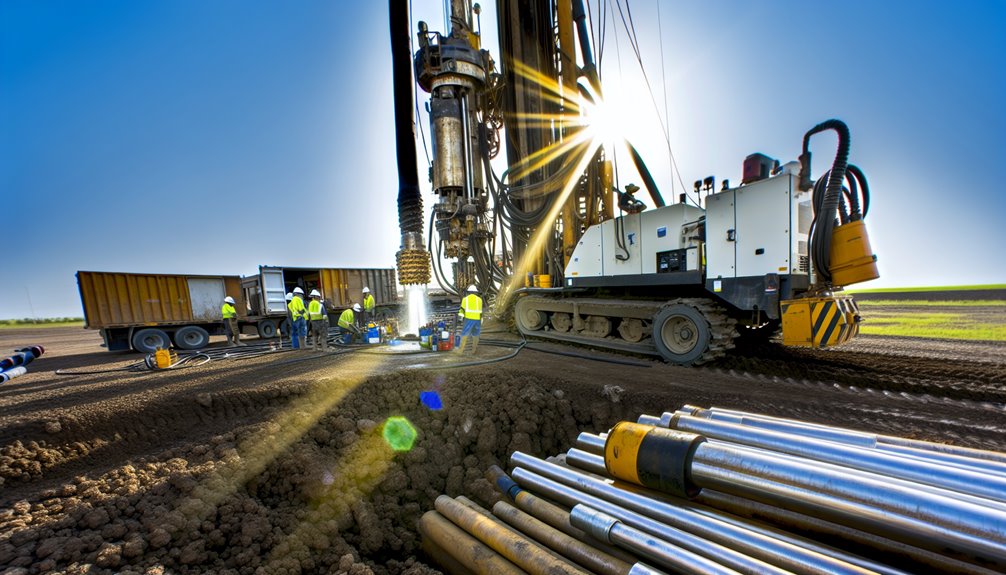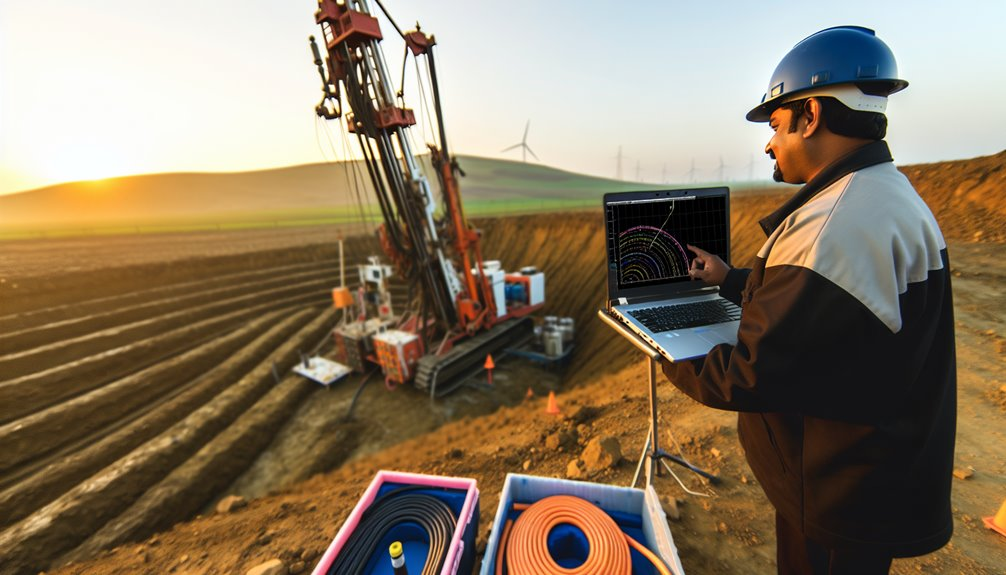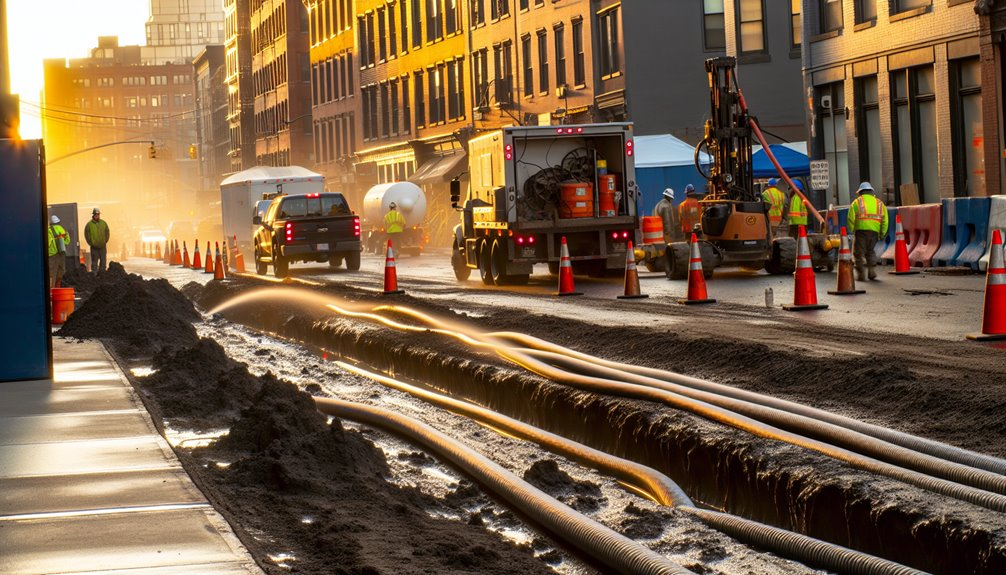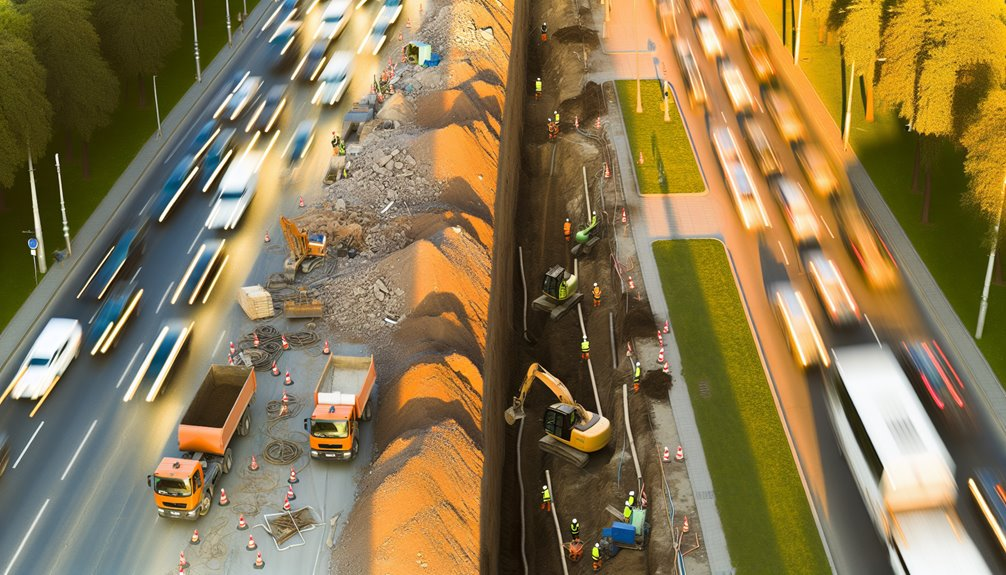When commencing a Horizontal Directional Drilling (HDD) project, you must first thoroughly assess soil and rock properties to tailor your approach effectively. This initial analysis can prevent costly miscalculations, as varying textures and hardness levels demand specific drilling strategies. By selecting equipment and technology that align with these ground conditions, you'll enhance your operational efficiency and mitigate potential risks. Let's explore how these foundational assessments can greatly influence the success of your HDD project.
Understanding Soil and Rock Properties for Effective HDD Planning
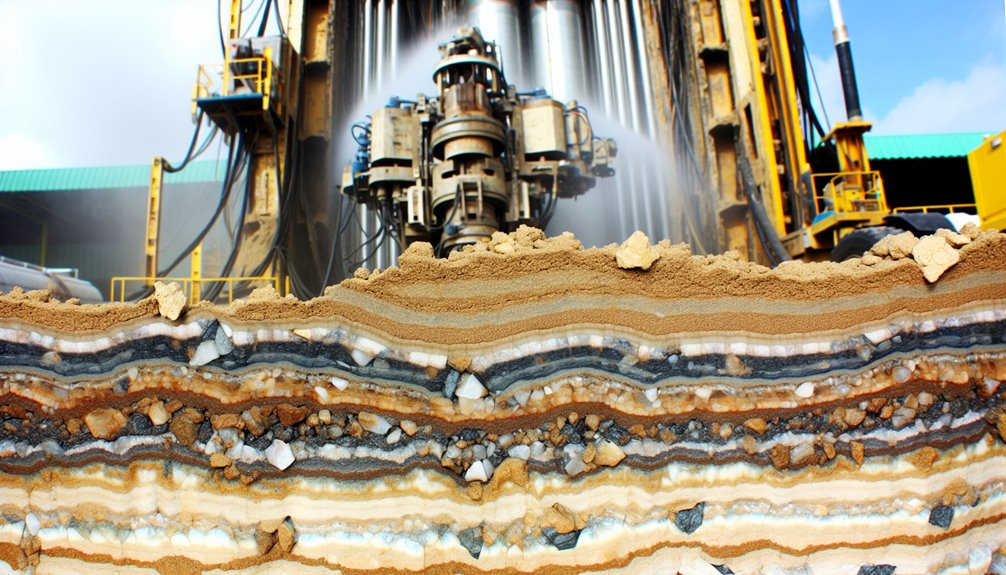
To effectively plan for Horizontal Directional Drilling (HDD), you must first understand the properties of the soil and rock at your project site.
The soil texture, ranging from coarse gravel to fine clay, considerably impacts the drilling dynamics. For instance, coarse-grained soils challenge fluidization, while fine-grained soils, like clays, can adhere to drilling equipment, increasing operational difficulties.
Rock hardness also plays a critical role; hard, abrasive rock formations can hinder the progress of HDD, demanding more robust, innovative solutions.
Moreover, the presence of large boulders or significant gravel content in the soil can lead to frequent tool changes and increased project delays, as these materials are tough to drill through and manage.
Selecting the Appropriate Drilling Equipment and Technology
As you select your drilling equipment, it's critical to evaluate the specifications of the drill rig, ensuring it can handle the size and weight of the pipes used in your project. Advanced navigation systems, such as GPR and electromagnetic locators, are essential for avoiding underground utilities and ensuring precise drilling paths. Your choice of tooling and accessories should align with the geological conditions and project requirements to optimize performance and safety. The rapid advancement in hard disk drive technologies showcases the ongoing innovation and relevance in storage solutions, mirroring the necessity for continuous improvement in drilling technologies.
Drill Rig Specifications
When selecting the appropriate horizontal directional drilling equipment, understanding the specifications and capabilities of different drill rigs is essential.
Small drill rigs, maneuverable and self-contained, offer pull forces up to 100,000 pounds and employ shorter 10-15 foot drill pipe joints, optimizing them for confined spaces and less demanding jobs.
Mid-sized rigs, balancing power and agility, handle more substantial pull forces between 100,000 and 400,000 pounds with longer 15-31 foot drill pipes, suitable for a broader range of projects.
Large rigs, designed for the most challenging environments, support pull forces up to 1.5 million pounds and utilize the longest standard drill pipes at 31 feet, ensuring high performance in extensive and complex drilling operations.
Always align drill rig selection with project demands to enhance efficiency and effectiveness in your drilling techniques.
Advanced Navigation Systems
Selecting the right advanced guidance systems for horizontal directional drilling is vital as these technologies greatly enhance the precision and safety of your operations.
GPS and GNSS systems provide real-time location data important for identifying the exact positions of the drill head and exit points, essential for drill path optimization.
Integration of gyrocompasses and inclinometers guarantees accurate measurement of the drill head's orientation, critical for maneuvering complex underground landscapes.
In addition, leveraging MW locators and utility mapping facilitates careful tracking of buried utilities, greatly reducing the risk of accidental strikes.
Advanced 3D modeling software and AI integration translate this data into actionable insights, enabling you to predict and navigate potential obstacles, securing efficient and safe drilling outcomes.
Tooling and Accessory Choices
After mastering the navigation systems necessary for horizontal directional drilling, it's equally important to focus on the equipment itself, specifically the tooling and accessories that drive the operation's success.
Your tool selection strategies must consider the specific ground conditions you'll encounter. Choose from carbide-tipped rock teeth or hardened shanks designed for durability in various soils, from clay to hard rock, ensuring ideal penetration rates and minimal wear.
Accessory enhancement techniques involve selecting the right drive chucks, sub savers, and vice jaws to maintain the integrity and efficiency of your operation.
Customizable housings and adapters allow for seamless adaptation to different drilling environments, enhancing project-specific performance.
The Importance of Accurate Route Planning and Site Surveying
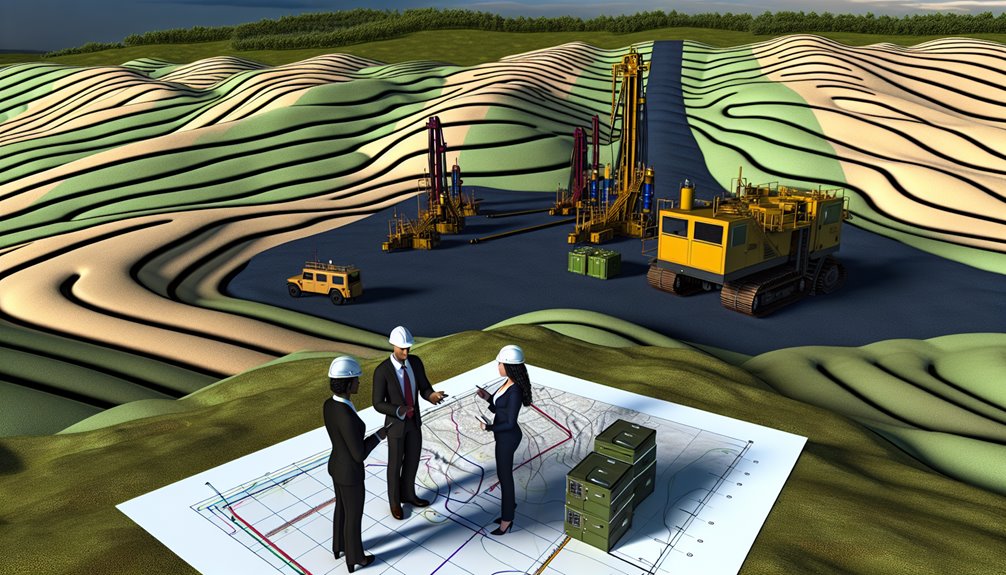
You'll find that conducting a thorough geological assessment is essential for identifying potential subsurface challenges that might impede the drilling process.
Maneuvering environmental constraints efficiently requires you to integrate precision mapping techniques from the outset. This approach guarantees not only the feasibility of your route but also optimizes the alignment to circumvent any unforeseen geological or infrastructural barriers.
Geological Assessment Essentials
Before initiating a horizontal directional drilling (HDD) project, it's crucial to conduct an extensive geological assessment to guarantee accurate route planning and effective site surveying.
You'll need to explore deep into geological mapping techniques and subsurface analysis methods. Start with a desktop study utilizing remote sensing imagery and aerial photography, coupled with published geological data.
Follow this with field reconnaissance led by expert geologists to pinpoint potential underground obstacles and assess subsurface stratigraphy, including particle size and strength properties.
Ensure geotechnical borings are sufficient and strategically placed to analyze soil cohesion, internal friction angles, and groundwater characteristics.
Embrace ground-penetrating radar and seismic surveys for precise utility and obstacle mapping, integrating advanced steering technologies to refine your HDD approach and mitigate risks effectively.
Navigating Environmental Constraints
When planning a horizontal directional drilling (HDD) project, accurately mapping the route and surveying the site are essential to navigate environmental constraints effectively.
You must guarantee that your project minimizes risks such as groundwater contamination and improper drilling fluid disposal. Here's how:
- Conduct extensive geotechnical borings to anticipate and mitigate cross-contamination between aquifers.
- Implement robust drilling fluid management systems to prevent inadvertent returns and leakage.
- Plan for emergency responses to quickly address potential contaminant releases.
- Guarantee proper decommissioning of abandoned boreholes to prevent long-term environmental impacts.
- Offset boreholes from the centerline of the drilled path to reduce the risk of drilling fluid surfacing, safeguarding nearby water bodies.
Mastering these elements fosters innovation while preserving environmental integrity.
Precision Mapping Techniques
As HDD projects advance in complexity, precision mapping techniques become indispensable for accurate route planning and site surveying.
You'll find that integrating advanced mapping software greatly enhances your ability to visualize complex geological data. This data visualization not only streamlines the route planning process but also guarantees that every layer of soil is accurately represented and analyzed.
The collaboration among design engineers, geotechnical experts, and contractors relies heavily on these detailed maps to select the most efficient drilling paths and tools.
Furthermore, such precision in planning and surveying minimizes risks of third-party damage and assures the pipeline complies with stringent safety standards.
Embrace these innovative mapping solutions to maintain the integrity and success of your HDD endeavors.
Best Practices for Drilling Fluid Management
To manage drilling fluid effectively, you must first understand its composition and primary functions. This foundational knowledge empowers you to enhance the fluid's performance, guaranteeing efficient and safe drilling operations.
- Assess Fluid Viscosity: Regularly measure and adjust the viscosity to maintain the balance needed for cutting transport and hole stability.
- Monitor pH Levels: Verify the fluid's pH is between 8 and 9 to enhance the effectiveness of bentonite and polymers.
- Utilize Appropriate Additives: Select additives like bentonite to improve lubrication and cooling properties.
- Continuous Testing: Implement routine sampling and testing to monitor fluid conditions and adjust as necessary.
- Visual Inspections: Regularly inspect the bore path and adjust the fluid composition to prevent anomalies.
These practices are essential in managing different drilling fluid types and maintaining ideal fluid viscosity for project success.
Addressing Environmental Concerns and Regulatory Compliance

After exploring best practices for managing drilling fluid to enhance the efficiency and safety of HDD operations, it's equally important to address the environmental concerns and secure regulatory compliance inherent in these projects.
As you plan your HDD projects, understanding and mitigating the environmental impact of actions like groundwater contamination and surface water disturbance is vital. This involves detailed pre-drill assessments, including geotechnical studies and hydrogeology data to anticipate and manage risks effectively.
Navigating the regulatory framework requires adherence to both broad and specific guidelines, from FERC's detailed oversight to state and local regulations.
Confirm compliance with critical acts like the Fisheries Act and Conservation Authorities Act, integrating continuous on-site environmental monitoring to swiftly address any deviations and safeguard ecological sensitivities.
Mitigating Risks and Responding to Unexpected Challenges
While horizontal directional drilling (HDD) offers significant advantages for underground installations, effective mitigation of risks and prompt responses to unforeseen challenges are essential to maintaining the integrity and efficiency of your projects.
You'll need a robust approach to risk assessment and the implementation of adaptive strategies to navigate these complexities.
- Conduct thorough geological and infrastructure surveys to strategically plan the bore path and prevent disruptions.
- Implement real-time monitoring systems that provide immediate data on subsurface conditions and drilling dynamics.
- Adapt drilling parameters in response to unexpected soil conditions using specialized tools and techniques.
- Maintain a preventive maintenance schedule for equipment to reduce failures and guarantee operational continuity.
- Utilize predictive analytics to foresee and mitigate potential challenges, enhancing decision-making processes during the project.
Conclusion
As you wrap up your HDD project, guarantee you've thoroughly analyzed soil and rock properties, chosen the right drill rig, and precisely planned your route. Always manage your drilling fluids meticulously and stay compliant with environmental regulations. Be proactive in mitigating risks and ready to tackle unforeseen challenges efficiently. By adhering to these best practices, you'll enhance operational efficiency and safeguard the environment, ultimately leading to the successful completion of your horizontal directional drilling project.
If you're looking to dive deeper into the world of horizontal directional drilling or have questions about your upcoming projects, I invite you to visit Boring Bros at boringbro.com or give us a call at (954) 639-6167. We'd love to help you out and share our expertise in this exciting field!

